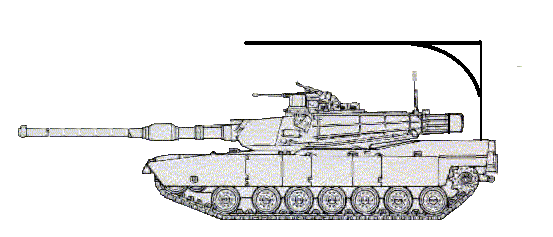Traditional anti-tank tactics are to hope for a flank or rear shot into thinner armor. However, tanks also have thin armor overhead. Advanced munitions have made "top attack" the favorite option for modern anti-tank weaponry, especially since it presents a larger target area. New TOW-2B, MPIM/SRAW "Predator", Bofors BILL, Spike, and Javelin anti-tank missiles, as well as advanced anti-tank gun rounds are designed to over-fly a tank and fire a submunition downward. US Army 155mm SADARM munitions deploy a parachute and use an infrared sensor to fire an anti-tank charge downward. Bofors of Sweden sells 120mm Strix anti-tank mortar rounds and 155mm BONUS projectiles with an infrared sensor in the nose, and the British are sell a similar 81mm Merlin mortar round.
Long-range missiles can explode overhead and litter an area with anti-armor submunitions that try to explode through whatever they fall upon. High-flying aircraft can drop munitions which float downward until an infrared sensor acquires a target, and the Brilliant Anti-Tank (BAT) munitions seek out loud engines. New RF seeking mortar rounds are a threat. Finally, a simple shoulder-launched RPGs can be fired downward from tall buildings, trees, or cliffs. Some tankers dismiss "top-attack" threats because these munitions usually miss their targets. However, the long-range of artillery and 120mm mortars allow "top attack" munitions to devastate armored units if only 10% of rounds hit a tank.
One solution is to add armor to a tank's topside, but this is very costly and will increase a tanks' weight by 20%. The Russians and Israelis resorted to sticking small reactive "exploding armor" plates on the turret. This provides some protection, but is dangerous to anyone outside the tank. The ideal solution is to use "armor spacing" in a major way by adding a steel canopy over tank turrets. A large plate of steel about a half inch thick can be mounted 3 ft. above the top of the tank turret, like a canopy. A simple design may resemble a large four-leg kitchen table welded to the turret. (below) The one drawback that the rear area becomes exposed as the turret turns.

Another option is a "diving board" attached to two heavy beams protruding from the rear of the tank (below). This design keeps the rear covered, but requires heavy support beams and does not allow the turret to rotate 360 degrees. It may have hinges to allow them to swing away from the rear area to allow engine replacement.

Whatever is used, tanks need a shield on top. Top-attack munitions and 20-30 mm aircraft and helicopter rounds can penetrate the canopy, but their explosive force will dissipate in the 3-foot space between the canopy and the tank itself. Collapsible side rails can be attached atop the canopy allowing extra storage space. Tanks may place sand bags on their canopy for added protection. If the canopy extends two feet past the rear, it can better shield the infrared signature of the engine, so infrared guided munitions from above strike at the hot exhaust flowing out behind a moving tank. A final advantage is that the canopy serves as a canopy. Tank commanders prefer to operate with an open hatch, yet a hot sun or rain makes that difficult.
A tank canopy also allows for curtains mounted on the sides and rear that can instantly be dropped down or pulled up by the tank commander, much like drop curtains used in some theaters. These will be used by tanks dug into defensive positions wishing to hide from aircraft, helicopters, UAVs, and satellites. They will be dropped if under attack from sensor guided munitions since the canopy only hides the engine heat directly above, while curtains hide it completely, along with its road wheels that heat up from use. Of course curtains restrict the tank commander's visibility and use of this .50 caliber machine gun, and they are likely to catch on things and become ripped over time, but they will prove valuable.
Curtains will also confuse pilots using millimeter wave radar or infrared imagers as a faint tank image can no longer be recognized after the curtain drops. These curtains may be "furry" to absorb laser light. Fur coats absorb around 80% of laser light as it is bounced around the fibers. Try this at home with a laser pointer. Furry curtains may cause incoming laser spot guided munitions like Hellfire to lose track of the laser reflection. Since curtains will not extend to cover the front of the tank, that can be targeted, but that is where tank armor is thickest. A final advantage is that curtains provide an instant tent for anyone who climbs aboard the tank while parked to escape the weather.
A canopy also helps hide tanks from satellites and aircraft. Even if an engine is cool, the sun quickly heats up a steel tank making it visible to infrared sensors, especially after dusk. A tank canopy coated with polyurethane insulation shades the tank and hides infrared sources underneath. It will also break up the distinctive shape of a tank turret, especially if the canopy has irregular curved edges. This is important because millimeter radar and lasers map the surface in any weather looking for tank shapes, even under camouflage. Most likely, the canopy will be covered with brush and other camouflage. A steel canopy with curtains is an inexpensive and simple modification necessary to protect tanks on the modern battlefield.
©2015 www.G2mil.com